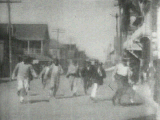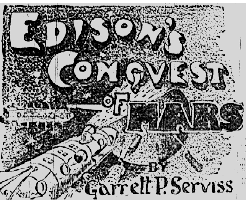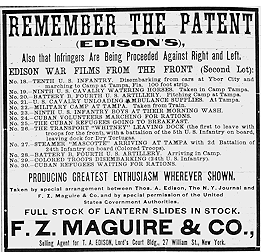Edison's Conquests
  |
 |
 |
[The] cumulative effects [of Spanish-American War films] were more than that of simply acting as visual newspapers. In their combination of journalism and patriotism, they extended an ideological force. They spectactularized war and the concept of U.S. imperialism as had never before been accomplished. (108)Edison selling agent F.Z. Maguire foregrounded the connection between Edison and Hearst in his advertising for Edison's War-graph. The connection between Hearst's New York Journal and the film industry already has been well documented by Musser, who notes that the publisher was quick to recognize the "propaganda value of [war] films [and] happily cooperated with Edison as well as Biograph" (Emergence 247). Advertisements for Biograph in the New York Clipper also announced "authentic war views" from their "camera now following North Atlantic Squadron on New York Journal, Anita," and Maguire continued to tout the "unprecedented sensation of "EDISON-JOURNAL CUBAN WAR FILMS" throughout the summer of 1898. Films like War Correspondents and New York Journal Despatch Yacht "Bucanner" further demonstrate the exploitation and promotion by the film industry of print journalism during this "correspondents war."
An interesting intertext in this context appeared in the Sunday Milwaukee Journal during the Spanish-American War. According to the science fiction serial Edison's Conquest of Mars, Thomas Alva Edison--who had also recently launched his patent wars against rival film companies ("REMEMBER THE PATENT" read one Edison ad)--embarks on a "Conquest of Mars," thus anticipating and extending the imperialist fantasy beyond Méliès' expansionist voyage to the moon to realize Cecil Rhodes' imperial desire to "annex the planets if [he] could." Described by author and amateur astronomer Garrett P. Serviss as a sequel to Wells' War of the Worlds, in "Edison's Conquest" the Wizard of Menlo Park harnesses the technology of electricity and other inventions to repel a Martian invasion and then annexes the planet. Replete with illustrations of floating Martians, exploding planets, and phallic spaceships, "Edison's Conquest of Mars" can be viewed as an imperialist subgenre of Edison science fiction.
 |  |
| Edison's Conquest of Mars
Milwaukee Sentinel 1898 | Edison's Patent Wars, New York Clipper 1898 |
For my purposes, however, the intertextual construction of Edison in the popular imagination as the putative inventor of cinema unwittingly underscores the prosthetic power of cinema to extend human perception and turn film viewers into spectating imperialists. Indeed, for a significant portion of the American public it was in fact Edison's "Wargraph" and "War-scope" that brought them news of American victories, and our global conquests were enacted in living pictures through the medium of his "great picture machine" at theaters across the country.
![]()
[Resisting Spectators] [Works Cited] [Resources]
[American Quarterly]